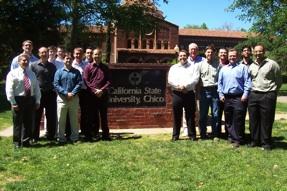A University Blends Mechatronics with Real-World Problem-Solving
August 5, 2015

At a small but growing number of STEM schools in the US, undergraduate and graduate students are being offered opportunities to learn a multidisciplinary, integrated systems approach to engineering, design, and modeling. Mechatronics, the place where mechanics, electronics, and computer science meet, is an increasingly popular discipline at schools whose goal is to turn out scientists capable of working in areas like robotics.
California State University, Chico (CSU) was the first school in California to offer an ABET-accredited degree program in mechatronic engineering. CSU’s California Mechatronics Center works in conjunction with Lawrence Livermore National Laboratory and specializes in robotics and surveillance vehicles. Nick Repanich, director of the center and adjunct research professor at CSU, told Design News the center was recently formalized.

The center tackles small but real-world projects from industry, using a novel approach that combines students, professors, and modern Internet audio/video tools. Gaining the trust of private industry meant making some changes. Even the name with which the facility identifies itself is more than skin deep.
“We decided (the center’s) branding might be important, as machines have an operational life way beyond the student, and customers would only want to try a project if they had confidence we would be around for as long as the machine,”Repanich said. “When we called ourselves a ‘Center,’ we quickly found out that ‘Institute’ and ‘Center’ are key terms within a university system that mean you are not just a professor doing research, but have board governance, goals, and space -- like a real company might have.”
MORE FROM DESIGN NEWS: The Engineering Shortage Is a Problem We All Can Solve
While most mechatronics students struggle to explain to their families and friends what they do -- according to Repanich, most of them say they do “robotics” -- businesses today are increasingly aware of the benefits that mechatronics expertise can bring them, and this knowledge is sending them to university mechatronics programs with partnerships in mind.
“Gradually, the term ‘mechatronics’ is becoming more common, as small microprocessors find their way into more devices and parts of our life, and the general populace sees more practical applications of mechatronics all around them,” Repanich told Design News. “Our practical goals are to find and complete those smaller ‘backburner’ machine automation projects that every company has but just cannot quite find the time or don't quite know how to complete.”
Providing students with real-world projects to cut their teeth on is an important step toward filling the growing market need for mechatronics experts. Mechatronics is highly interdisciplinary, so it involves teamwork and collaboration. Teamwork, Repanich told Design News, is necessary because limited physical resources (i.e., workstations) demand a team approach. He cautioned, however, that mechatronics programs should not lose sight of helping students gain individual problem-solving skills.
“We have overdone it [with team projects], and now team learning generally serves to hide and promote weaker students through a degree program they otherwise might not have been able to complete,” he said. “Some is good, more is not better, as we end up with grade inflation and degreed engineers that are not up to the task. I like to think that a better thing to teach, rather than ‘collaboration,’ would be ‘use your resources.’ The hardest thing to teach young engineers is that the first resource to find is a person, not a search engine. Pick up the phone instead of a keyboard.”
MORE FROM DESIGN NEWS: Mechatronics Matches Growing Complexity of Intelligent Factories

We’re heading to Philly! Design & Manufacturing Philadelphia will take place Oct. 7-8. Get up close with the latest design and manufacturing technologies, meet qualified suppliers for your applications, and expand your network. Learn from experts at educational conferences and specialty events. Register today and join us at Philadelphia’s premier industry showcase!
Tracey Schelmetic graduated from Fairfield University in Fairfield, Conn. and began her long career as a technology and science writer and editor at Appleton & Lange, the now-defunct medical publishing arm of Simon & Schuster. Later, as the editorial director of telecom trade journal Customer Interaction Solutions (today Customer magazine) she became a well-recognized voice in the contact center industry. Today, she is a freelance writer specializing in manufacturing and technology, telecommunications, and enterprise software.
About the Author(s)
You May Also Like


.jpg?width=300&auto=webp&quality=80&disable=upscale)


